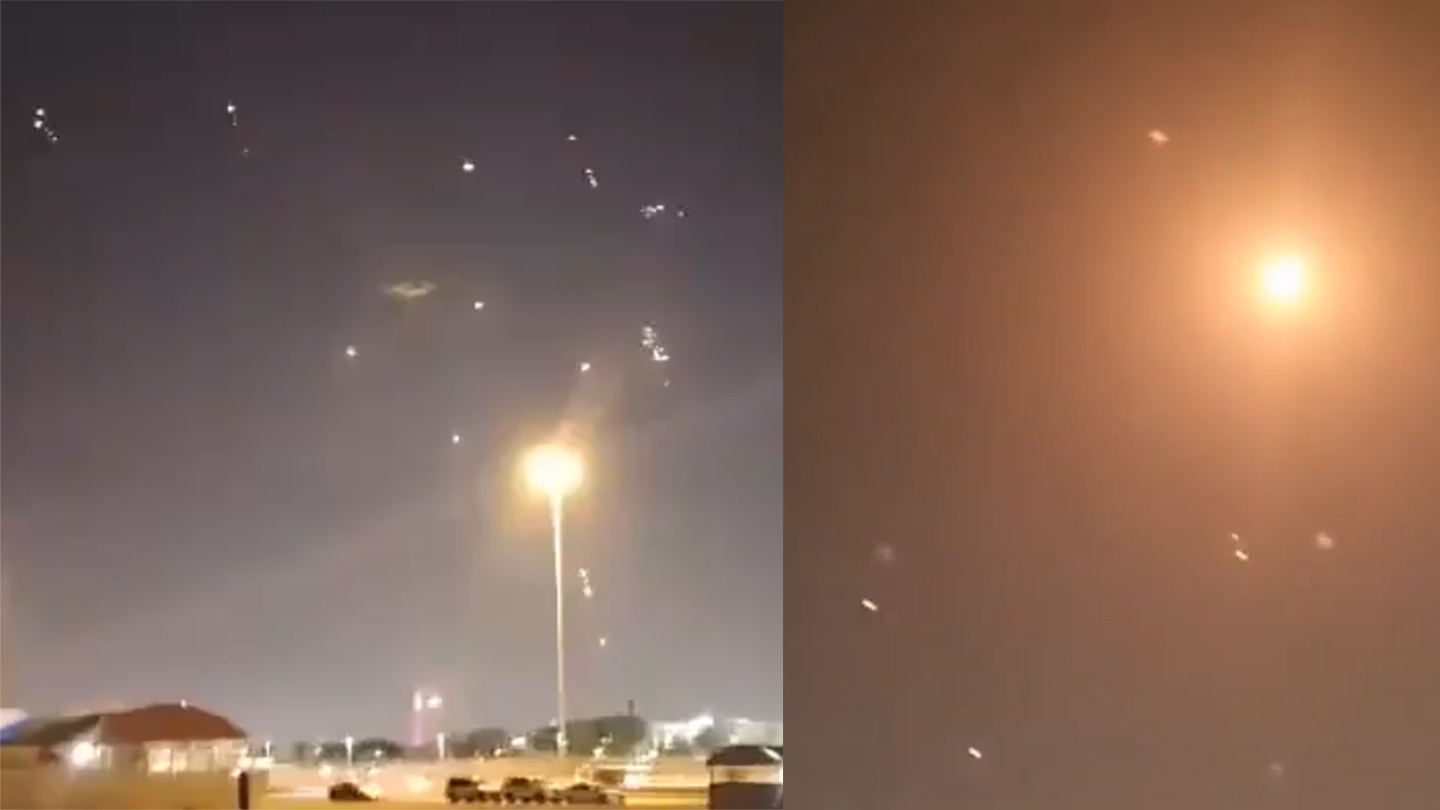Iran has begun attacking U.S. interests in the Middle East in retaliation for Saturday’s Operation Midnight Hammer attack on three Iranian nuclear facilities. You can read more about that operation in our initial report here.
Iran reportedly launched 10 ballistic missiles at U.S. targets in Qatar, home to the sprawling Al Udeid Air Base, an Israeli official said, Israeli N12 news outlet reporter Amit Segal posted on X.
Images are emerging on social media of strikes at U.S. bases across the region.
There are also reports that sirens were sounding in Bahrain and Kuwait, where the U.S. has military bases.
U.S. forces have reportedly been told to seek shelter in Iraq.
Earlier, Iran moved “missile launchers into place for a potential attack on U.S. forces in the Middle East in response to the surprise American strike on three nuclear sites over the weekend,” Wall Street Journal reporter Lara Seligman reported on X, citing U.S. officials.
In addition, it appears that airspace over Qatar has been closed. Qatar is where Al Udeid Air Base, the largest U.S. military installation in the region, is located. As we reported last week, the Air Force has already moved non-sheltered aircraft out of that base.
Earlier on Monday, the U.S. and U.K. embassies in Qatar issued warnings to citizens.
The U.S. has troops at multiple bases around the region, including airbases in Saudi Arabia, Jordan, the United Arab Emirates and Qatar, the headquarters of the 5th Fleet in Bahrain, and bases in Iraq, Kuwait and Syria. But, as we’ve previously noted, sprawling Camp Lemonnier, located in Djibouti, sits just 80 miles across the Bab al-Mandab Strait from Yemen. The base has been used for U.S. operations in Yemen for years, as well as a key facility for America’s support of the Saudi-led Arab coalition against the Houthis.
The U.S. attack gives Iran a “free hand” to respond, that country’s top military leader said on Monday.
“Regardless of the extent of the damages incurred, the very nature of this crime (U.S. attack on nuclear sites) will not go unanswered,” Major General Seyed Abdolrahim Mousavi, Chief of Staff of Iran’s Armed Forces threatened on Monday, according to the official Iranian Press TV outlet.
This is a developing story. Stay with TWZ for updates.
Update: 1:24 PM Eastern –
Officials in Qatar said they successfully intercepted the missiles and reserved the right to respond to the Iranian attack.
Qatar called the attack a flagrant violation.
Update: 1:27 PM Eastern –
Iran is calling its attack Operation Herald of Victory, according to the official Iranian Press TV news outlet.
“Iranian armed forces have launched a missile barrage at American military bases in Qatar in a retaliatory operation a day after Iranian nuclear sites were targeted by US bombers,” Press TV announced.
Update 1:35 PM Eastern –
Iran reportedly tried to mollify Qatar, saying their actions don’t pose a threat to “our friendly and brotherly” neighbor, Reuters reporter Phil Stewart reported on X. Iran has shared the best relations with Qatar of all the Gulf States. The two share a huge natural gas field.
Video is emerging of Patriot PAC-3 MSE interceptors being launched.
Another video showed what appeared to be Qatari interceptors falling to the ground after being launched without causing significant explosions.
Iran reportedly shared a graphic illustration of its missiles striking an empty Al Udeid.
Update: 1:45 PM Eastern –
Analysis and context:
If this ballistic missile barrage on Al Udeid is an isolated reprisal operation (we don’t know for sure if that is the case just yet), then this was checking a box to save face for the regime. It also signals just how weakened Iran is at this point. We have to wait and see, but this has heavy shades of the 2020 reprisal ballistic missile strikes in Iraq, although this barrage was even less potent.
If this is the case, this is also a grand signal to the Trump administration that they have been provided an off-ramp and to take it.
A huge part of this is likely the state of Iran’s command and control architecture, which appears to be in tatters. Even if they have the hardware, coordinating a major operation rapidly is likely very challenging, if not impossible, at this point. Also, the delay in the reprisal strike highlights this reality. Note that Israel focused on going after regime command and control sites today.
So, this could be it, at least for the time being, for direct engagements between the U.S. and Iran. In the past, Trump has taken advantage of such opportunities.
Update: 1:54 PM Eastern –
A U.S. defense official released a statement on the Al Udeid attack.
“I can confirm that Al Udeid Air Base was attacked by short-range and medium-range ballistic missiles originating from Iran today. At this time, there are no reports of U.S. casualties. We are monitoring this situation closely and will provide more information as it becomes available.”
Update: 2:23 PM Eastern –
Iran gave the U.S. advanced notice of the attack, CNN reported.
“The coordination was intended to minimize casualties and preserve an off-ramp,” the network stated, citing a source.
Saudi Arabia announced its solidarity with Qatar, calling the Iranian attack “a flagrant violation of international law” and that “all its capabilities” are “at Qatar’s disposal in support of any measures it may take.”
It should be noted that the two nations severed ties in 2017 and only restored them in 2021.
It appears the immediate threat of a kinetic response to the Iranian attack on Al Udeid is subsiding for the moment, at least. Flight tracking software shows that airspace is once again open over the UAE.
Update: 4:14 PM Eastern –
Right on cue, as predicted, Trump exits the kinetic component of the war between Israel and Iran:

More on the supposed ceasefire deal can be found on our new post we are live-updating here.
Contact the author: howard@thewarzone.com
